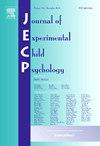早产儿和足月儿空间语言发展:对象探索和父母空间输入的作用
IF 1.8
2区 心理学
Q3 PSYCHOLOGY, DEVELOPMENTAL
引用次数: 0
摘要
婴儿通过探索来学习物体的特征和物体之间的关系。与这些空间特征相关的客体探索和父母的言语输入可能导致空间语言发展的级联反应。本纵向研究考察了时间1(年龄= 13.7个月)婴儿的物体探索和父母的空间输入是否能预测时间2(年龄= 26个月)早产儿(平均胎龄= 30周)和足月婴儿(平均胎龄= 38.9周)的空间语言。时间1的对象探索和父母的空间输入通过半结构化的自由游戏会话进行编码,婴儿的空间语言通过时间2的父母报告进行评估。我们的结果显示,早产儿和足月组在物体探索方面没有差异。然而,父母的空间输入因新生儿状况而异,早产儿的空间输入少于足月婴儿。父母空间输入与44%的客体探索事件同时发生,组间差异显著(早产儿:M = 36.1%;足月:M = 52.1%)。重要的是,无论儿童的新生儿状态如何,时间1时的物体探索和父母空间输入之间的相互作用预测了儿童在时间2时的空间语言知识。在时间1中,探索物体时间较长且从父母那里获得更多空间输入的婴儿,在时间2中比在时间1中探索物体时间较短且获得较少输入的婴儿知道更多空间单词。这些发现表明,早期的物体探索和父母的空间输入共同导致了早产儿和足月婴儿后期空间语言发展的级联效应。本文章由计算机程序翻译,如有差异,请以英文原文为准。
Spatial language development in preterm and full-term infants: The role of object exploration and parents’ spatial input
Infants learn object features and relations among objects by exploring them. Object exploration and parents’ verbal input related to these spatial characteristics may lead to cascades for the development of spatial language. This longitudinal study examined whether infant object exploration and parents’ spatial input at Time 1 (Mage = 13.7 months) predicted spatial language of preterm infants (mean gestational age = 30 weeks) and full-term infants (mean gestational age = 38.9 weeks) at Time 2 (Mage = 26 months). The object exploration and parents’ spatial input at Time 1 were coded from the semi-structured free play sessions, and infant spatial language was assessed via a parental report at Time 2. Our results showed no differences between preterm and full-term groups on object exploration. However, parents’ spatial input differed based on neonatal condition, in which preterm infants received less input than full-term infants. Parents’ spatial input co-occurred with 44% of the object exploration events, with a significant difference between groups (preterm: M = 36.1%; full-term: M = 52.1%). Importantly, the interaction between object exploration and parents’ spatial input at Time 1 predicted children’s spatial language knowledge at Time 2 regardless of children’s neonatal status. Infants who explored objects for longer periods and received greater spatial input from their parents at Time 1 knew more spatial words at Time 2 than infants who explored objects less and received less input at Time 1. These findings suggest that early object exploration and parents’ spatial input together can lead to a cascading effect on later spatial language development for both preterm and full-term infants.
求助全文
通过发布文献求助,成功后即可免费获取论文全文。
去求助
来源期刊

Journal of Experimental Child Psychology
Multiple-
CiteScore
4.50
自引率
7.70%
发文量
190
期刊介绍:
The Journal of Experimental Child Psychology is an excellent source of information concerning all aspects of the development of children. It includes empirical psychological research on cognitive, social/emotional, and physical development. In addition, the journal periodically publishes Special Topic issues.
 求助内容:
求助内容: 应助结果提醒方式:
应助结果提醒方式:


